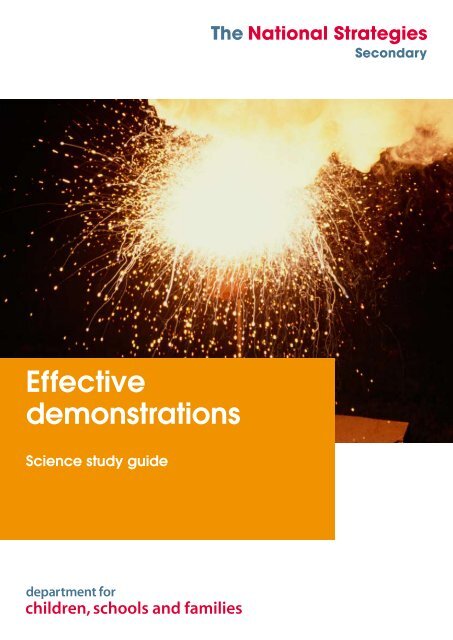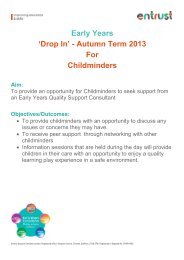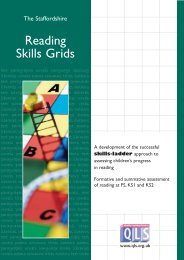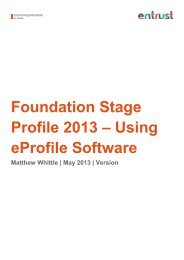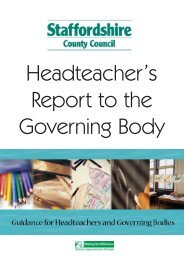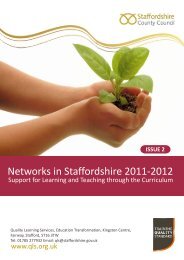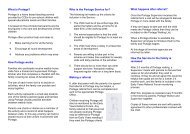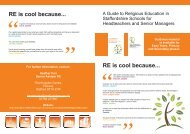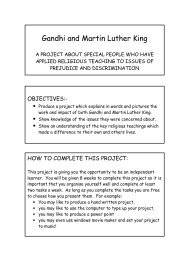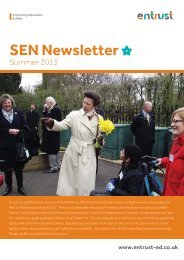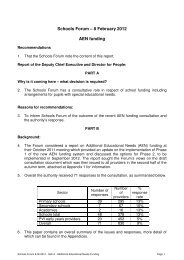Effective demonstrations booklet (401 KB) - Staffordshire Learning Net
Effective demonstrations booklet (401 KB) - Staffordshire Learning Net
Effective demonstrations booklet (401 KB) - Staffordshire Learning Net
You also want an ePaper? Increase the reach of your titles
YUMPU automatically turns print PDFs into web optimized ePapers that Google loves.
<strong>Effective</strong><br />
<strong>demonstrations</strong><br />
Science study guide
Disclaimer<br />
The Department for Children, Schools and Families<br />
wishes to make it clear that the Department and<br />
its agents accept no responsibility for the actual<br />
content of any materials suggested as information<br />
sources in this publication, whether these are in the<br />
form of printed publications or on a website.<br />
In these materials icons, logos, software products<br />
and websites are used for contextual and practical<br />
reasons. Their use should not be interpreted as<br />
an endorsement of particular companies or their<br />
products.<br />
The websites referred to in these materials existed<br />
at the time of going to print.<br />
Please check all website references carefully to<br />
see if they have changed and substitute other<br />
references where appropriate.
<strong>Effective</strong> <strong>demonstrations</strong><br />
First published in 2008<br />
Ref: 00094-2008DVD-EN
Contents<br />
© Crown copyright 2008<br />
The National Strategies | Secondary<br />
<strong>Effective</strong> <strong>demonstrations</strong><br />
How to use this study guide 3<br />
Introduction 5<br />
Why carry out <strong>demonstrations</strong>? 7<br />
Reviewing your own practice 10<br />
What makes a demonstration effective? 14<br />
Using <strong>demonstrations</strong> to develop higher-order thinking skills 18<br />
Planning <strong>demonstrations</strong> 23<br />
Demonstrations for ‘open days’ and similar events 25<br />
Safety and some myths 26<br />
Next steps 27<br />
Appendix 1: Extracts from the Programme of Study for Science 28<br />
Appendix 2: <strong>Effective</strong> teaching and learning in science 32<br />
Appendix 3: Additional resources to support effective <strong>demonstrations</strong> 34<br />
Appendix 4: References 36<br />
1<br />
00094-2008DVD-EN
© Crown copyright 2008<br />
The National Strategies | Secondary<br />
<strong>Effective</strong> <strong>demonstrations</strong><br />
How to use this study guide<br />
This guide is one of a suite of five guides that have been produced in response to the<br />
government’s SIIF (Science and Innovation Investment Framework) agenda. They are<br />
designed to highlight aspects of interactive teaching and give teachers practical and<br />
innovative tips and advice to ensure that pupils enjoy their science experience.<br />
This study guide offers practical suggestions for you to use in the classroom when<br />
considering effective <strong>demonstrations</strong>. All the strategies suggested have been tried and<br />
tested by teachers. They draw upon academic research and the experience of<br />
Strengthening teaching and learning through using different pedagogies<br />
(DfES 0703-2004 G). While there are similarities with these materials you will find that<br />
this unit gives specific advice that will be immediately relevant.<br />
Your science consultant can help you work through this unit or you should team up with<br />
a colleague(s) who also wishes to better enhance the quality of effective<br />
<strong>demonstrations</strong> for pupils. The unit contains case studies and tasks for you to undertake<br />
which may encourage you to consider the advice or try out new techniques in the<br />
classroom. It also contains ‘reflections’ which will help you revise an idea or change your<br />
own practice. Finally you are invited to reflect on the experience of having tried out new<br />
materials and to identify follow-up work.<br />
You can work through the materials in a number of ways:<br />
● Start small; choose one class to work with. Ask another teacher or your subject<br />
leader to help by providing a sounding board for your ideas.<br />
● Work with your science consultant on developing and planning the use of a<br />
demonstration. After three weeks, meet together to review progress. Discuss which<br />
strategies have been the most effective with one class and plan to use these with<br />
other classes.<br />
● Find another science teacher to pair with and team-teach. Design the activities<br />
together and divide the teacher’s role between you.<br />
● Work with a group of teachers in the department. Use the unit as a focus for joint<br />
working, meet regularly to share ideas and then review progress after a few weeks.<br />
Identify the sections of the unit that are the most appropriate for you and focus on<br />
those. You may find it helpful to keep a learning log as you work through the tasks.<br />
You could add this to your personal CPD portfolio.<br />
3<br />
00094-2008DVD-EN
Introduction<br />
© Crown copyright 2008<br />
The National Strategies | Secondary<br />
<strong>Effective</strong> <strong>demonstrations</strong><br />
In this guide we consider how the use of demonstration experiments can contribute to<br />
enhancing the quality of teaching and learning in science.<br />
Within the different sections of this guide we will explore:<br />
● reasons for carrying out demonstration experiments;<br />
● different types of <strong>demonstrations</strong> and the different situations in which<br />
<strong>demonstrations</strong> are used;<br />
● how to make <strong>demonstrations</strong> as effective as possible.<br />
In your teaching, you will already be using ‘<strong>demonstrations</strong>’ in a whole variety of ways<br />
on a day-to-day basis. Perhaps, for example, you have shown the pupils how to interpret<br />
a graph using a data projector or interactive whiteboard. This and other types of<br />
practical activity are considered in more detail in one of the other guides in this suite,<br />
‘Interactive Practicals’<br />
The focus here is on practical <strong>demonstrations</strong>, which have a long tradition in the<br />
teaching and exposition of science at all levels. The use of <strong>demonstrations</strong> to illustrate<br />
scientific theories or processes has been a tool valued by scientists for many<br />
generations.<br />
An effective demonstration is a stimulus for high quality discussion and dialogue.<br />
Through these interactions, pupils' understanding can be explored, challenged and<br />
developed with the use of appropriate questions to provide cognitive conflict and<br />
gently move pupils out of their comfort zones.<br />
5<br />
00094-2008DVD-EN
6 The National Strategies | Secondary<br />
<strong>Effective</strong> <strong>demonstrations</strong><br />
Reflection<br />
As you work through this guide, reflect upon the four modes of interaction described<br />
by Professor Phil Scott in the introduction to the Interactive Teaching DVD.<br />
Modes of Interaction<br />
Focus on science<br />
view (Authoritative)<br />
Open to different<br />
points of view<br />
(Dialogic)<br />
00094-2008DVD-EN<br />
Interactive Non-Interactive<br />
Presentation<br />
Q and A<br />
Probing<br />
Elaborating<br />
Prompting<br />
Presentation<br />
Lecture<br />
Review<br />
Which type of interaction describes your typical demonstration?<br />
What would a dialogic interactive demonstration look like?<br />
© Crown copyright 2008
© Crown copyright 2008<br />
The National Strategies | Secondary<br />
<strong>Effective</strong> <strong>demonstrations</strong><br />
Why carry out <strong>demonstrations</strong>?<br />
Demonstrations allow you to:<br />
● show experiments that are too dangerous or complex for pupils to carry out<br />
themselves (this may, in some cases, need to be assessed in terms of the aptitudes,<br />
attitudes and behaviour of the pupils);<br />
● direct the pupils to specific points of interest;<br />
● emphasise important, relevant aspects and avoid irrelevant or secondary<br />
distractions (in effect, to cut out the ‘background noise’);<br />
● focus attention on the link between scientific phenomena (the practical reality) and<br />
the underlying theories;<br />
● repeat experiments for emphasis of a specific effect or point;<br />
● model a particular aspect of science, whilst leading pupils to explore their<br />
understanding of the phenomena they observe.<br />
There is the perception among some that pupil engagement in scientific enquiry<br />
activities means that the pupils themselves should carry out a large amount of<br />
investigative practical work. Demonstrations can provide wonderful scientific enquiry<br />
opportunities, sometimes more effectively than pupils carrying out their own<br />
experimental work. However, in order to be effective, it is important that pupils are<br />
actively engaged with the demonstration and are aware of the purpose of the<br />
demonstration and how it links to the desired learning outcomes.<br />
The focus on the learning objectives and desired learning outcomes of a practical<br />
activity can, occasionally, be lost when an experiment is carried out as a class practical.<br />
The pupils may be too busy collecting apparatus, finding the bits and pieces they need,<br />
reading and/or following instructions, or standing watching others doing, to recognise<br />
the point of the experiment. The pupils may be fully occupied but may also learn very<br />
little in the process.<br />
Of course, it is a fine balancing act – there should be plenty of opportunities for pupils<br />
to carry out their own practical work. As an effective teacher, you will have considered<br />
how the class practical or demonstration contributes to the desired learning outcomes<br />
and explored the advantages and disadvantages of conducting a class practical or<br />
demonstration with a particular group of students.<br />
Demonstrations offer you a valuable tool with which you can help pupils develop their<br />
knowledge and understanding of scientific concepts and processes. We know that<br />
effective learning takes place when pupils are actively engaged so intervention, and<br />
interactive teaching are crucial for successful learning in science (see Appendix 2).<br />
7<br />
00094-2008DVD-EN
8 The National Strategies | Secondary<br />
<strong>Effective</strong> <strong>demonstrations</strong><br />
Demonstration activities provide an ideal opportunity for leading whole-class, direct,<br />
interactive teaching. In this way, all pupils have contact with the teacher in the<br />
undertaking of a shared task. The teaching should be oral, collaborative and lively –<br />
a two-way process in which the pupils are expected to play an active part 1 .<br />
Reflection<br />
Consider a demonstration experiment you have recently carried out.<br />
How did you ensure that the pupils were actively involved? What did you do and<br />
what did the pupils do? What was the impact of the demonstration on learning?<br />
What do you think you could do differently to improve the effectiveness of that<br />
demonstration?<br />
Task 1<br />
Read the following outline descriptions of two different approaches to a Key Stage 3<br />
lesson about acids, alkalis and salts.<br />
In which one were the pupils more actively involved?<br />
How could this involvement have supported the learning?<br />
Case study<br />
Teacher A<br />
A worksheet was handed out to the class. The pupils were introduced to the task by<br />
the teacher who went through the instructions for the preparation of sodium<br />
chloride, demonstrating each step of the process. The teacher explained words such<br />
as indicator, pH, neutralisation, filtration and saturated solution during the<br />
demonstration.<br />
After observing the demonstration, the pupils then carried out the experiment by<br />
following the instructions on the worksheet.<br />
00094-2008DVD-EN<br />
© Crown copyright 2008
Case study<br />
© Crown copyright 2008<br />
The National Strategies | Secondary<br />
<strong>Effective</strong> <strong>demonstrations</strong><br />
Teacher B<br />
The teacher began the lesson with a question and answer session to review ideas<br />
about the reactions of acids and alkalis. The pupils were then set the problem of<br />
how to prepare a sample of pure sodium chloride. They were provided with a set of<br />
cards and, working in small groups, used the cards to devise a sequence of<br />
instructions for preparing the salt.<br />
An interim ‘plenary’ session was then held to discuss the sequence of steps required<br />
and the reasons for them. The teacher demonstrated each of the agreed steps and<br />
coordinated a class discussion about the process – the pupils made their own rough<br />
notes about the procedure before going on to prepare their salt.<br />
Demonstrations enable pupils to experience the pleasure of discovery; of seeing,<br />
smelling and experiencing phenomena that are new to them. Well-prepared, wellperformed<br />
<strong>demonstrations</strong> can inspire and motivate pupils and can be enjoyable and<br />
entertaining events.<br />
9<br />
00094-2008DVD-EN
10 The National Strategies | Secondary<br />
<strong>Effective</strong> <strong>demonstrations</strong><br />
Reviewing your own practice<br />
Before going on to look at how you can make <strong>demonstrations</strong> more effective, it is worth<br />
reflecting on your experience to date and the range of demonstration activities<br />
undertaken in your department.<br />
Task 2<br />
Working with a colleague, look through your departmental scheme of work for a<br />
particular year group in either KS3 or KS4.<br />
Make a list of the demonstration activities included in the scheme of work.<br />
Make a brief note of the learning objectives that indicate that <strong>demonstrations</strong> were<br />
a suitable choice of activity in order to encourage learning.<br />
Keep this list for Task 3.<br />
Types of demonstration<br />
When we think about demonstration experiments, the first thing that comes to mind is<br />
often the ‘show’ or ‘performance’ type of demonstration. However, in reality, most<br />
teachers employ a wide range of demonstration types throughout their lessons.<br />
Many <strong>demonstrations</strong> are also conducted by pupils, either to the whole class (often with<br />
the support of the teacher) or informally when working in small groups. Peer<br />
<strong>demonstrations</strong> can be a useful means to spark discussion and also challenge the<br />
demonstrator to explain and justify their actions.<br />
00094-2008DVD-EN<br />
© Crown copyright 2008
Type of demonstration2 Example<br />
Performance: likely to be elaborate or<br />
complex experiments that may also be<br />
too difficult, or too dangerous for pupils<br />
to carry out themselves. Alternatively it<br />
may be used to model a particular skill.<br />
Spontaneous: apparently<br />
unpremeditated experiments, done on<br />
the spur of the moment, within the<br />
context of the planned lesson. Used to:<br />
● clarify a point, answer a question or<br />
address a misconception<br />
● provide a reminder of factual<br />
information<br />
Note: This is not an excuse to include a<br />
demonstration without proper<br />
planning and safety consideration.<br />
Spontaneous <strong>demonstrations</strong> should<br />
make use of equipment already<br />
planned for use within the lesson, but<br />
applied so as to address emerging<br />
issues in response to pupils' progress.<br />
Serial: a linked sequence of short,<br />
individual experiments designed to<br />
help pupils develop understanding of a<br />
key concept.<br />
Marathon: experiments that require<br />
several days, or even weeks, to be<br />
completed.<br />
© Crown copyright 2008<br />
The National Strategies | Secondary<br />
<strong>Effective</strong> <strong>demonstrations</strong><br />
A conducting sphere is suspended<br />
between two metal plates connected to<br />
a van der Graaff generator – to show<br />
that moving charge forms an electric<br />
current.<br />
Reaction of sodium with water.<br />
Radioactivity experiments.<br />
The Thermit reaction<br />
Quick ‘gas jar-scale’ reminder of the<br />
colours of Universal Indicator.<br />
Using ‘playground trolleys’ and rope to<br />
provide convincing evidence that forces<br />
come in pairs.<br />
Use of kinetics trolleys to extend<br />
questions and challenge understanding<br />
about collisions.<br />
Series of experiments to illustrate<br />
diffusion: e.g. potassium manganate<br />
(VII) crystals in water; ammonia smell;<br />
horizontal diffusion tube with ammonia<br />
and hydrogen chloride.<br />
Effect of dark and light on production of<br />
starch by a series of photosynthesising<br />
plants kept in different conditions over<br />
a period of 2–3 weeks.<br />
11<br />
00094-2008DVD-EN
12 The National Strategies | Secondary<br />
<strong>Effective</strong> <strong>demonstrations</strong><br />
Task 3<br />
Consider the types of demonstration shown in the table on page 11.<br />
Review the list of demonstration activities you collated in Task 2.<br />
● For each activity; decide which type of demonstration it is ( Performance, Serial,<br />
or Marathon). Record your decisions.<br />
● Make a note of any occasions where you have carried out a Spontaneous<br />
demonstration. Briefly describe why you carried out the demonstration.<br />
What questions did you ask the pupils whilst conducting the demonstration?<br />
How did this help them to make progress?<br />
Situations for <strong>demonstrations</strong><br />
There is a wide range of situations in which a demonstration could be carried out,<br />
including:<br />
●<br />
●<br />
●<br />
●<br />
●<br />
●<br />
●<br />
as a stimulating ‘starter’ activity;<br />
as the key activity or main focus of a lesson or series of lessons;<br />
as a concluding, plenary or summary activity;<br />
to demonstrate a technique (before pupils attempt an experiment);<br />
to highlight health and safety issues (before pupils attempt an experiment);<br />
as a revision activity;<br />
for ‘open day’ or other, similar events (see p25).<br />
The most important issue is to consider how and why the delivery of a demonstration<br />
will be the most effective way to encourage learning.<br />
Task 4<br />
Reflect on a demonstration activity you have conducted in each of the situations<br />
above. For each one, decide which type of demonstration was involved and why<br />
this was appropriate for the particular situation.<br />
●<br />
Was the demonstration effective? How do you know?<br />
00094-2008DVD-EN<br />
© Crown copyright 2008
© Crown copyright 2008<br />
The National Strategies | Secondary<br />
<strong>Effective</strong> <strong>demonstrations</strong><br />
<strong>Learning</strong> objectives and learning outcomes<br />
Like many teaching strategies, <strong>demonstrations</strong> are one strategy which can be used to<br />
focus on different aspects of teaching and learning. These could include:<br />
● providing opportunities for direct observation of scientific phenomena and<br />
processes;<br />
● showing how evidence links with scientific ideas;<br />
● helping to improve and clarify pupils’ knowledge and understanding of scientific<br />
concepts, models and theories;<br />
● developing reasoning and problem-solving skills;<br />
● exploring ‘how we know’.<br />
The choice to demonstrate an activity, rather than conducting a group or class practical,<br />
should be governed by the expected learning outcomes. It is the nature of the<br />
interaction and discussion between the teacher and pupils, and within groups of pupils,<br />
during the demonstration which makes this approach suitable for developing pupils'<br />
understanding of science.<br />
Task 5<br />
Review again your collated list of <strong>demonstrations</strong> from Tasks 1–4.<br />
●<br />
Categorise the <strong>demonstrations</strong> according to the teaching and learning aspects<br />
described above.<br />
Refer to this list as you work through the rest of the guide.<br />
Reflection<br />
In Tasks 1–4 you reviewed some aspects of the <strong>demonstrations</strong> included in your<br />
scheme of work for a particular year group.<br />
You have:<br />
● considered the subject-specific reasons for carrying out the <strong>demonstrations</strong>;<br />
● classified the <strong>demonstrations</strong> by ‘type’: Performance, Serial, Marathon or<br />
Spontaneous;<br />
● considered the situations in which the <strong>demonstrations</strong> were carried out;<br />
● categorised the <strong>demonstrations</strong> by teaching and learning aspect.<br />
How satisfied are you with the decision-making process behind choosing to carry<br />
out a demonstration activity?<br />
Are there now any decisions you would want to change? Why?<br />
13<br />
00094-2008DVD-EN
14 The National Strategies | Secondary<br />
<strong>Effective</strong> <strong>demonstrations</strong><br />
What makes a demonstration<br />
effective?<br />
Some of the key features of an effective demonstration include:<br />
●<br />
●<br />
●<br />
●<br />
●<br />
●<br />
●<br />
the presentation is interactive, lively and engaging and the pupils are actively<br />
involved and required to think or apply their knowledge;<br />
the activity is clearly focused on the lesson objectives (i.e. they are ‘fit for purpose’);<br />
the teacher is well prepared and has, if necessary, rehearsed both the practical and<br />
interactive aspects of the activity;<br />
the demonstration makes an impact on learning;<br />
the demonstration is safe;<br />
the demonstration is well presented, tidy and uncluttered;<br />
the demonstration is visible to the whole class.<br />
Demonstrations should be interactive, lively and engage the pupils<br />
This needs some careful thought. What will you do and what will the pupils do<br />
throughout the demonstration in order to ensure that the activity maintains the pupils’<br />
attention and enables progression to take place?<br />
Carrying out a demonstration and teaching effectively at the same time is not easy to<br />
do well and is a skill that should not be underestimated. As the teacher, you need to<br />
concentrate on what you’re doing with the experiment as well as being able to ask<br />
questions, keep the pupils’ attention and ensure the demonstration helps them to<br />
progress towards the desired learning outcomes. This is why rehearsal is often essential.<br />
A variety of activities can be used to engage and focus the pupils during a<br />
demonstration. These include:<br />
●<br />
●<br />
●<br />
●<br />
●<br />
●<br />
arranging a pre-prepared series of statements (e.g. cards describing the process<br />
being demonstrated) into the correct order;<br />
using mini-whiteboards (on which to make notes or draw diagrams or concept<br />
cartoons) in response to your questions and prompts;<br />
completing a 'structured' worksheet by recording observations for further<br />
discussion after the demonstration;<br />
'traffic lighting' a series of statements according to their relevance to the process<br />
being observed;<br />
predicting and explaining what the outcome of the next stage might be;<br />
contributing to the selection of variables and the direction of the demonstration<br />
when this is possible (and safe to do so).<br />
00094-2008DVD-EN<br />
© Crown copyright 2008
© Crown copyright 2008<br />
The National Strategies | Secondary<br />
<strong>Effective</strong> <strong>demonstrations</strong><br />
For some <strong>demonstrations</strong>, it may be appropriate to involve a pupil in carrying out one<br />
or more of the steps (refer to the Safety and some myths section). You may also be able to<br />
involve the technician or teaching assistant.<br />
Demonstrations should be ‘focused on the learning objectives’<br />
Demonstrations should be carried out to meet specific teaching and learning<br />
objectives. The inclusion of a demonstration activity should be an integral part of lesson<br />
planning and the decision to include a specific demonstration should be driven by the<br />
desired outcomes.<br />
Demonstrations should be well prepared and, if necessary,<br />
rehearsed<br />
Thorough preparation is essential. A demonstration that does not work can have a<br />
negative impact on teaching and learning (although a confident or more experienced<br />
teacher can turn the ‘failed experiment’ into a valuable learning experience regarding<br />
scientific enquiry!).<br />
The demonstration should be rehearsed in full before performing it in front of a class.<br />
Never be tempted to ‘have a go’ at a new demonstration for the first time with a class in<br />
the laboratory.<br />
As you practice each stage of the experiment, think about how to make each step<br />
interactive.<br />
●<br />
●<br />
●<br />
What do you expect pupils to do during the demonstration?<br />
What do you expect pupils to learn during the demonstration?<br />
What questions will you ask to check pupils' understanding of what they are<br />
observing and to move their understanding forward?<br />
As you rehearse you will be able to see what happens, how long things take, what could<br />
‘go wrong’, how and where to lay things out, what apparatus and materials you need to<br />
hand and how much space you will need; you will have the opportunity to think<br />
through the activities that the pupils can do during the demonstration and be able to<br />
pre-empt some of the pupils’ questions.<br />
Don’t forget that some of the apparatus, materials and techniques may be very new to<br />
the pupils. Names, spellings and functions may need to be explained. Consider the level<br />
of understanding and background knowledge of your audience.<br />
It is a good idea to jot down some reminder notes or ‘prompts’ for the lesson as you<br />
rehearse the experiment.<br />
Ideally, you should aim to have the demonstration ready at the start of the lesson before<br />
the pupils arrive. Make sure that you also have spare apparatus and materials (e.g.<br />
chemicals) as appropriate. Involve your technician at the earliest possible stage in<br />
planning.<br />
15<br />
00094-2008DVD-EN
16 The National Strategies | Secondary<br />
<strong>Effective</strong> <strong>demonstrations</strong><br />
Demonstrations should make an impact<br />
The best <strong>demonstrations</strong> are memorable because they vividly illustrate scientific<br />
phenomena. <strong>Effective</strong> <strong>demonstrations</strong> help the pupils to make vital links between the<br />
physical reality of their experience and abstract theory. Even the simplest<br />
<strong>demonstrations</strong> can have a long-lasting, positive effect on learning.<br />
Demonstrations must be safe<br />
Safety is an important consideration and more detailed information is provided in the<br />
Safety and some myths section.<br />
Most of the above points apply to all types of demonstration. Some additional<br />
consideration needs to be given to <strong>demonstrations</strong> other than the ‘performance’ style.<br />
These styles of demonstration include:<br />
● Spontaneous: Often, when planning your lessons, you may be able to identify, or<br />
pre-empt a ‘spontaneous’ demonstration. This will enable you to have the relevant<br />
materials and apparatus to hand and to have thought through the implications (in<br />
terms of the learning objectives and health and safety issues). Do not be tempted to<br />
perform a demonstration you are unsure of.<br />
● Serial: Demonstrations that require you to carry out a series of short, individual<br />
experiments will need careful planning. Lay out the experiments in the order you<br />
intend to carry them out. Consider putting the different ‘part’ experiments in<br />
different locations in the classroom.<br />
● Marathon: Demonstration experiments that run over several days or weeks can be<br />
very difficult to manage effectively. Give some thought about how to maintain the<br />
pupils’ interest in the experiment (what will they do on each separate occasion?).<br />
‘Forgotten’ or ‘abandoned’ marathon experiments can be a great source of<br />
frustration for keen pupils.<br />
Also consider where to store the experiment so that observations can continue but so<br />
that it is not in the way of other practical work or in danger of being interfered with.<br />
Demonstrations should be tidy and uncluttered<br />
Make sure that the bench where you are carrying out the demonstration is free from all<br />
clutter (this includes random bits of apparatus, textbooks and last week’s marking pile!).<br />
You may find it helpful for some <strong>demonstrations</strong> to use a contrasting backdrop (e.g.<br />
pieces of thick black or white card) to help ensure that the demonstration itself is at the<br />
centre of attention.<br />
Demonstrations should be visible to all pupils and as large-scale as<br />
possible (if appropriate and safe)<br />
For some experiments, it is possible to scale up the amounts and/or the size of the<br />
apparatus.<br />
For example, a demonstration of the effect of dry ice (solid carbon dioxide) on the pH of<br />
a Universal Indicator solution can be carried out using gas jars rather than boiling tubes<br />
or beakers.<br />
00094-2008DVD-EN<br />
© Crown copyright 2008
© Crown copyright 2008<br />
The National Strategies | Secondary<br />
<strong>Effective</strong> <strong>demonstrations</strong><br />
In other cases it may be appropriate to use visual aids or ICT facilities. A flexicamera<br />
connected to a data projector or interactive whiteboard can be useful when<br />
demonstrating a necessarily small-scale experiment, such as helping pupils to<br />
understand the view down a microscope when studying plant and animal cells.<br />
Think carefully about where you will perform the demonstration. As part of your<br />
rehearsal, walk around the laboratory and view the demonstration from the pupils’<br />
perspective.<br />
●<br />
●<br />
●<br />
●<br />
Where will they be sitting or standing?<br />
Will they get a clear view of what’s going on?<br />
Will they need to write things down during the demonstration?<br />
What do you need to consider if the demonstration is being carried out elsewhere<br />
(e.g. outside)?<br />
How will you resolve these issues? The art of presentation is an essential part of being an<br />
effective teacher. Think about visibility, audibility, focus of attention, pupil participation,<br />
contrasts and comparisons.<br />
Always remember, however, that the demonstration, not the demonstrator, should be<br />
the focus of attention!<br />
17<br />
00094-2008DVD-EN
18 The National Strategies | Secondary<br />
<strong>Effective</strong> <strong>demonstrations</strong><br />
Using <strong>demonstrations</strong> to develop<br />
higher-order thinking skills<br />
Demonstration activities are ideal opportunities to develop scientific enquiry skills so it<br />
is important for you to consider the thinking skills being assumed or targeted during the<br />
activity.<br />
The table in Figure 1 below suggests one way of relating the focus of a demonstration,<br />
in terms of the teaching objectives and learning outcomes, to the hierarchy of thinking<br />
skills based on Bloom’s Taxonomy.<br />
All too often, <strong>demonstrations</strong> are aimed at lower-order thinking skills. How can you use<br />
a demonstration to target some of the higher-order skills?<br />
Higher-order Lower-order<br />
Figure 1<br />
Thinking<br />
skill<br />
Knowledge<br />
Comprehension<br />
Application<br />
Analysis<br />
Synthesis<br />
Evaluation<br />
00094-2008DVD-EN<br />
Focus of<br />
demonstration Action words<br />
Observing and<br />
recalling<br />
scientific<br />
phenomena<br />
and processes<br />
Linking evidence<br />
with scientific<br />
ideas<br />
Clarifying<br />
knowledge and<br />
understanding of<br />
concepts, models<br />
and theories<br />
Applying<br />
scientific ideas in<br />
new contexts or<br />
situations<br />
Developing<br />
reasoning and<br />
problem-solving<br />
skills<br />
Exploring ‘how<br />
we know’<br />
Name<br />
Recall<br />
Describe<br />
Compare<br />
Interpret<br />
Relate<br />
Prioritise<br />
Reason<br />
Reflect<br />
Design<br />
Summarise<br />
Judge<br />
Identify<br />
State<br />
Explain<br />
Classify<br />
Apply ideas<br />
Solve<br />
Infer<br />
Draw<br />
conclusions<br />
Predict<br />
Speculate /<br />
hypothesise<br />
Assess<br />
Dialogue /<br />
questions<br />
Give me the<br />
equation for<br />
…<br />
What happens<br />
when …?<br />
Identify the<br />
main parts of<br />
…<br />
What did you<br />
observe …?<br />
How could<br />
you classify<br />
…?<br />
What’s the<br />
difference …?<br />
How can we<br />
find out …?<br />
© Crown copyright 2008
Task 6<br />
© Crown copyright 2008<br />
The National Strategies | Secondary<br />
<strong>Effective</strong> <strong>demonstrations</strong><br />
Appendix 1 shows some of the statements for a selection of topics taken from the<br />
KS3 Programmes of study (existing and 2008) plus some statements for the same<br />
topics from the 2006 GCSE Science and Additional Science Criteria.<br />
●<br />
●<br />
For each of the main topic areas shown in Appendix 1, work with another<br />
teacher (for example, another subject specialist) or your science consultant to<br />
think of some ideas for <strong>demonstrations</strong> that could be developed to challenge<br />
pupils’ higher-order thinking.<br />
Display your list in the department base or prep room and ask other colleagues<br />
to add to the list.<br />
Some suggestions for <strong>demonstrations</strong> linked to the topic areas shown in Appendix 1 are<br />
given in Figure 2. Most of these suggestions are taken from one or more of the sources<br />
listed in Appendix 3. It provides a list of just a few of the many sources of information and<br />
ideas for <strong>demonstrations</strong>. Many of the resources provide detailed instructions for<br />
specific experiments.<br />
Task 7<br />
Spend 15–20 minutes searching some of the websites listed in Appendix 3.<br />
Aim to find at least one additional demonstration activity for each of the main topic<br />
areas listed in Appendix 1.<br />
Add these ideas to the list of <strong>demonstrations</strong> from Task 6.<br />
Share your findings with the rest of the department.<br />
Figure 2<br />
Topic area Demonstration examples<br />
Plant nutrition (KS3)<br />
Energy flow and element cycles (GCSE)<br />
Genetics (KS3)<br />
Organisms, behaviour and health (KS3 ‘08)<br />
Organisms and health (GCSE)<br />
(A) ‘The amazing concertina cactus’ –<br />
to investigate the uptake of water by<br />
plants. See Appendix 3 (2).<br />
(B) Using algal balls to investigate<br />
photosynthesis. See Appendix 3 (2).<br />
(C) Using rapid-cycling brassica plants<br />
to investigate inheritance and<br />
variation. See Appendix 3 (2).<br />
19<br />
00094-2008DVD-EN
20 The National Strategies | Secondary<br />
<strong>Effective</strong> <strong>demonstrations</strong><br />
Figure 2<br />
Topic area Demonstration examples<br />
Particles (KS3)<br />
Chemical & material behaviour<br />
(KS3 ‘08, KS4)<br />
Structure and bonding (GCSE)<br />
Forces (KS3)<br />
Energy, electricity and forces (KS3 ‘08)<br />
Forces and motion (GCSE)<br />
Electricity and magnetism (KS3)<br />
Energy, electricity and forces (KS3 ‘08)<br />
Forces and motion (GCSE)<br />
00094-2008DVD-EN<br />
(D) Using helium balloons to<br />
demonstrate diffusion or<br />
demonstrating diffusion with<br />
nitrogen dioxide (rather than<br />
bromine). See Appendix 3 (1).<br />
(E) Demonstrating crystal growth<br />
under a microscope to investigate<br />
ideas about the arrangement of<br />
particles in solids and liquids 2 .<br />
(F) Testing a non-Newtonian fluid or<br />
‘silly putty’ to illustrate states of<br />
matter and how structure and<br />
bonding affects properties.<br />
(G) Using a top-pan balance and<br />
marbles to illustrate how gas<br />
molecules exert pressure. See<br />
Appendix 3 (3).<br />
(H) ‘Egg and sheet’ demonstration to<br />
illustrate force and the effectiveness<br />
of ‘air bags’. See Appendix 3 (3).<br />
(I) Using sparklers, a drill, a marble and<br />
a drainpipe, a bung on a string and an<br />
apple to introduce circular motion!<br />
See Appendix 3 (3).<br />
(J) Galileo’s Rolling Ball experiment<br />
(Newton’s First Law and a hint at his<br />
Second Law). See Appendix 3 (3).<br />
(K) Large-scale demonstration to<br />
show that electrically charged<br />
materials exert forces on each other<br />
that may be attractive or repelling.<br />
See Appendix 3 (3).<br />
(L) Lamps in parallel – demonstration<br />
to show that the current flowing in a<br />
circuit increases as more lamps are<br />
added in parallel with each other. See<br />
Appendix 3 (3).<br />
2 School chemistry experiments – a collection of tried and tested experiments for use in schools, R.F Farley (ASE, 2001).<br />
© Crown copyright 2008
© Crown copyright 2008<br />
The National Strategies | Secondary<br />
<strong>Effective</strong> <strong>demonstrations</strong><br />
The level of thinking skill that the pupils will need to employ will obviously depend on<br />
the nature of the demonstration, the way in which pupils are involved and the 'thinking<br />
demand' of the activity you set for them. For any given demonstration, there are two<br />
levels of demand which need to be considered; the conceptual demand of the situation<br />
being demonstrated and the thinking demand provided by the nature of the questions<br />
being asked. Ideally, the pupils will be engaged in a variety of tasks which target a range<br />
of thinking skills, progressing from lower to higher order.<br />
Task 8<br />
The table overleaf provides some suggested activities linked to the <strong>demonstrations</strong><br />
described above.<br />
●<br />
●<br />
●<br />
●<br />
Select five <strong>demonstrations</strong> from the list that you collated in Tasks 6 and 7. Try to<br />
ensure that you have a range of ‘types’ of demonstration and that at least one of<br />
the <strong>demonstrations</strong> comes from a topic you are going to teach soon.<br />
Working with another teacher, devise a range of pupil activities for each<br />
demonstration. Ensure that the activities for any given demonstration cover a<br />
range of higher-order thinking skills where possible. Use the examples in the<br />
table below to help.<br />
Keep a written record of your ideas.<br />
Working with another teacher, devise a range of questions that you could ask<br />
pupils during three of the <strong>demonstrations</strong> listed. Ensure that the questions you<br />
write are appropriate to develop the thinking of pupils with a range of abilities.<br />
21<br />
00094-2008DVD-EN
22 The National Strategies | Secondary<br />
<strong>Effective</strong> <strong>demonstrations</strong><br />
Higher-order thinking Lower-order thinking<br />
00094-2008DVD-EN<br />
Focus of<br />
demonstration<br />
Observing and recalling<br />
scientific phenomena and<br />
processes<br />
Linking evidence with<br />
scientific ideas<br />
Clarifying knowledge and<br />
understanding of concepts,<br />
models and theories<br />
Applying scientific ideas in<br />
new contexts or situations<br />
Developing reasoning and<br />
problem-solving skills<br />
Example of activities<br />
(Linked to examples identified in figure 2)<br />
(L) Produce a visual representation of the<br />
circuit by arranging a series or preprepared<br />
'component' cards including<br />
ammeters with appropriate values.<br />
(A), (B) Complete a pre-prepared table to<br />
describe how these particular plants<br />
obtain each of the things they need to be<br />
able to grow in their environments.<br />
(D) Write a diary description of your<br />
observations after a helium balloon is<br />
released in the laboratory and left for 3<br />
days.<br />
(D) Using your understanding of particles,<br />
draw a cartoon to explain why the brown<br />
gas took so long to diffuse into the top gas<br />
jar.<br />
(C) Why do the brassica plants grown in<br />
the F1 generation show the characteristics<br />
they do? What are their phenotypes and<br />
genotypes? How could you confirm the<br />
genotypes?<br />
(I) When considering circular motion,<br />
sketch what you predict will happen to the<br />
marble in the drainpipe. Explain why you<br />
think this will happen.<br />
(I) On the diagram, sketch what actually<br />
happened to the marble. Discuss your<br />
observations with a partner and work as a<br />
pair to come up with an explanation using<br />
your understanding of forces.<br />
Exploring ‘how we know’ (E) What experimental evidence do we<br />
have that the particles in a solid are<br />
regularly arranged and packed tightly<br />
together? How valid and reliable are the<br />
conclusions we can draw from this<br />
evidence?<br />
© Crown copyright 2008
© Crown copyright 2008<br />
The National Strategies | Secondary<br />
<strong>Effective</strong> <strong>demonstrations</strong><br />
Planning <strong>demonstrations</strong><br />
The inclusion of a demonstration activity must be an integral part of the lessonplanning<br />
process and it is essential to plan demonstration experiments carefully if they<br />
are to be an effective device in your teaching repertoire. ‘Spontaneous’ <strong>demonstrations</strong><br />
arise naturally during the course of a lesson but they still require careful thought.<br />
Think it through. Before investing time and effort in the developing, planning and<br />
carrying out a demonstration, be absolutely clear in your own mind that the<br />
demonstration provides the best opportunity for delivering the learning objectives and<br />
outcomes you want to achieve for that particular group of pupils.<br />
In developing a lesson plan, you should aim to be able to answer each of the following<br />
questions with reference to the proposed demonstration activity.<br />
● Why is a demonstration appropriate? How will it support pupil learning?<br />
● What demonstration experiment will be carried out?<br />
● What is the main objective of the demonstration?<br />
● What will you do?<br />
● How will you make the demonstration interactive for the pupils? (What questions/<br />
prompts will you use? How do you expect pupils to respond? What misconceptions<br />
may this demonstration unearth? How will you help all pupils to develop their<br />
understanding during the demonstration?)<br />
● How will the demonstration be carried out?<br />
● How much guidance do you need?<br />
● How can you find out more about doing the demonstration?<br />
● Where will the demonstration take place?<br />
● Where will the demonstration be laid out?<br />
● Where will the pupils be?<br />
● When in the lesson will the demonstration take place?<br />
● What will be the sequence of events?<br />
● Who will be involved in the planning, preparing and carrying out?<br />
Find and develop resources. Experienced teachers are often an excellent source of<br />
information and ideas and some teachers are always on the lookout for new ideas or<br />
interesting ‘twists’ on the tried and tested experiments. Technicians often have some<br />
great ideas and it is always sensible to involve them in your planning at the earliest stage<br />
possible.<br />
23<br />
00094-2008DVD-EN
24 The National Strategies | Secondary<br />
<strong>Effective</strong> <strong>demonstrations</strong><br />
There are many other good sources of information for practical experiments. Some are<br />
described in Appendices 3 and 4.<br />
Selecting, and then carrying out, a suitable demonstration can be quite difficult.<br />
There are some simple steps that you can take towards ensuring that the demonstration<br />
activities you carry out are effective – in terms of the learning objectives and outcomes<br />
as well as in terms of impact and enjoyment. If both you and the pupils enjoy and<br />
understand the demonstration, then this is more likely to enhance the learning that<br />
takes place.<br />
Practical tip<br />
Some useful points to consider as a ‘checklist’ or to bear in mind when planning a<br />
demonstration activity include:<br />
●<br />
●<br />
What do you want the main learning objective of the demonstration to be?<br />
How will the demonstration help pupils clarify their understanding?<br />
Will the demonstration challenge pupils’ thinking?<br />
What key questions will you need to ask?<br />
What misconceptions might emerge during the demonstration?<br />
How will you support pupils who hold these alternative views to make progress?<br />
How does the demonstration allow the active engagement of pupils?<br />
What interactions are possible?<br />
Task 9<br />
● Considering a demonstration from a topic that you are going to teach soon (Task<br />
8), plan a lesson to include this demonstration, indicating how the inclusion of<br />
this demonstration will support pupils in their learning.<br />
● Make notes on the demonstration which include answers to: Why? What? How?<br />
Where? When? and Who? Ensure your plan includes a range of activities that<br />
will engage the pupils and which challenge the pupils’ thinking.<br />
● Teach the lesson and evaluate how successful it was.<br />
● This would be a good opportunity for you to be observed teaching by your<br />
teacher partner or science consultant, and to jointly reflect on the effectiveness<br />
of the demonstration lesson.<br />
00094-2008DVD-EN<br />
© Crown copyright 2008
© Crown copyright 2008<br />
The National Strategies | Secondary<br />
<strong>Effective</strong> <strong>demonstrations</strong><br />
Demonstrations for 'open days'<br />
and similar events<br />
School science departments are often involved in putting on displays or<br />
<strong>demonstrations</strong> for events such as ‘open days’, science-week activities and primary<br />
liaison days.<br />
These <strong>demonstrations</strong> need to be planned carefully since a number of additional factors<br />
need to be taken into account over and above the demands for a ‘standard’ classroom<br />
lesson demonstration.<br />
Some key points to consider include:<br />
● Visitors The age, knowledge levels, health and behaviour of visitors will vary greatly<br />
and be largely unknown (e.g. a visitor may have asthma or a severe allergy). Visitors<br />
are unlikely to be familiar with laboratory rules.<br />
● Risk assessments If the aim of the event is to illustrate the normal range of activities<br />
that pupils engage in, then it would make sense to demonstrate some of the<br />
activities from the science department’s scheme of work for the year groups in<br />
question. If this is the case, then a risk assessment will already be available. If,<br />
however, the decision has been made to arrange ‘spectacular’ <strong>demonstrations</strong>, not<br />
normally performed in the course of the academic year, then additional risk<br />
assessments will need to be made.<br />
Visitors should take part in an activity only if the risk is minimal or if the risks have<br />
been assessed, and appropriate control measures put in place.<br />
● Supervision This can be very difficult during ‘open day’ type events and places an<br />
additional burden on science teaching and support staff. Thought should be given<br />
to organising the activities so that the teachers involved in actually supervising or<br />
carrying out a demonstration are not also required to act as ‘host’ for the visitors.<br />
Those involved in supervising must ensure that eye protection is worn when<br />
necessary and that other safety measures are adhered to. Consider cordoning off<br />
demonstration areas.<br />
● Security Give some thought as to how to prevent accidental or wilful theft of<br />
apparatus and materials, especially chemicals. Ensure that visitors cannot gain access<br />
to unsupervised laboratories or the prep room.<br />
Workload<br />
● Events such as these add substantially to the workload of all concerned.<br />
Allow sufficient time for planning, preparing, setting out and clearing away. Involve<br />
your technicians and teaching assistants in the discussions and decision making at<br />
the earliest opportunity.<br />
25<br />
00094-2008DVD-EN
26 The National Strategies | Secondary<br />
<strong>Effective</strong> <strong>demonstrations</strong><br />
Safety and some myths<br />
Some myths Disappointingly, there continues to be the perception among many<br />
people associated with, or interested in, science education in schools that health and<br />
safety concerns restrict what is and what is not possible in terms of experimental work.<br />
In 2005, CLEAPSS was commissioned by the Royal Society of Chemistry (RSC) to<br />
investigate whether effective teaching of practical science (across all the sciences) was<br />
being inhibited on spurious health and safety grounds. The report, Surely that’s banned?,<br />
found that these concerns were largely justified. The investigation found that:<br />
There are significant misunderstandings on the part of teachers and technicians about the<br />
chemicals and scientific activities which are banned in secondary schools and some teaching<br />
is inhibited by unjustified concerns about health and safety.<br />
In addition, the report stated that there were very few local authority bans which could<br />
be blamed for restricting practical science activities in schools.<br />
While acknowledging that lack of resources and time may hinder some activities, the<br />
report concluded that it appeared that many teachers or heads of department simply<br />
did not access much of the advice and guidance provided.<br />
The full report is available on the RSC website at www.rsc.org/Education/Policy/<br />
SurelyThatsBanned.asp<br />
Encouraging practical science There is a wealth of guidance, support and information<br />
available to school science teachers to enable them to undertake exciting practical<br />
activities safely. Some of these resources are listed below and others are given in the<br />
Additional resources section of this guide. Model risk assessments and other guidance<br />
can be found in these texts. Teachers are strongly advised to consult them.<br />
Safeguards in the School Laboratory, 11th edition, ASE, 2006<br />
Topics in Safety, 3rd edition, ASE, 2001<br />
Hazcards*, CLEAPSS, 2007 (or later updates)<br />
Recipe cards*, CLEAPSS, 1999 (or later updates)<br />
Laboratory Handbook*, CLEAPSS (updated annually)<br />
*These, and other CLEAPSS publications, are on the CLEAPSS Science Publications<br />
CD-ROM which is issued annually to members. More information about CLEAPSS can be<br />
found in Appendix 3.<br />
00094-2008DVD-EN<br />
© Crown copyright 2008
Next steps<br />
© Crown copyright 2008<br />
The National Strategies | Secondary<br />
<strong>Effective</strong> <strong>demonstrations</strong><br />
In this unit there have been several suggestions for you to pair with another teacher or<br />
your science consultant as a means of support while you develop your confidence in<br />
planning and carrying out practical <strong>demonstrations</strong>.<br />
●<br />
●<br />
●<br />
●<br />
●<br />
●<br />
●<br />
Start small: select one topic for a particular year group and aim to develop or<br />
practice a few demonstration activities which will meet the required teaching and<br />
learning objectives.<br />
Ask another teacher, your head of department or your science consultant to help<br />
you. You may have an AST in your school who may be able to help you review the<br />
effectiveness of the pupil activities that link to the demonstration.<br />
Ask for some protected time to research resources and to develop your lesson plans<br />
for your teaching. You will also need some time to rehearse the <strong>demonstrations</strong>.<br />
Make sure your head of department or line manager knows what you are doing.<br />
Observe other teachers doing <strong>demonstrations</strong> and evaluate the approach they take.<br />
Discuss your ideas with them.<br />
Work with your science consultant or another teacher to develop a bank of effective<br />
demonstration experiments (including linked pupil activities) for your scheme of<br />
work for a particular year group.<br />
Invite an AST to observe you teach a lesson which includes a demonstration<br />
experiment and ask them to comment on the range of activities undertaken and<br />
questions asked by the pupils during the demonstration.<br />
27<br />
00094-2008DVD-EN
28 The National Strategies | Secondary<br />
<strong>Effective</strong> <strong>demonstrations</strong><br />
Appendix 1:<br />
Extracts from the Programme of Study for Science<br />
00094-2008DVD-EN<br />
Statement from existing KS3 Programme of study Statements from 2008 KS3 Programme of<br />
study<br />
Pupils should be taught: The study of science should include:<br />
Plant nutrition Sc2 (3)<br />
that plants need carbon dioxide, water and light for photosynthesis,<br />
and produce biomass and oxygen<br />
●<br />
to summarise photosynthesis in a word equation<br />
●<br />
that nitrogen and other elements, in addition to carbon, oxygen and<br />
hydrogen, are required for plant growth<br />
●<br />
the role of root hairs in absorbing water and minerals from the soil<br />
●<br />
3.3 Organisms, behaviour and health<br />
Genetics Sc2 (4)<br />
about environmental and inherited causes of variation within a species<br />
all living things show variation – this includes<br />
inherited and environmental variation and variation<br />
through genetic engineering and selective breeding<br />
●<br />
●<br />
that selective breeding can lead to new varieties<br />
●<br />
© Crown copyright 2008
3.2 Chemical and material behaviour<br />
the particle model provides explanations for the<br />
different physical properties and behaviour of matter<br />
●<br />
Particles Sc3 (1) (2)<br />
how the particle theory of matter can be used to explain the properties<br />
of solids, liquids and gases, including changes of state, gas pressure and<br />
diffusion<br />
●<br />
that when physical changes take place (e.g. changes of state, formation<br />
of solutions), mass is conserved<br />
●<br />
© Crown copyright 2008<br />
to relate changes of state to energy transfers<br />
●<br />
3.1 Energy, electricity and forces<br />
forces are interactions between objects and can affect<br />
their shape and motion (this includes pressure effects,<br />
linear motion and turning moments)<br />
●<br />
Forces Sc4 (2)<br />
● how to determine the speed of a moving object and to use the<br />
quantitative relationship between speed, distance and time that the<br />
weight of an object on Earth is the result of its gravitational attraction<br />
between its mass and that of the Earth<br />
The National Strategies | Secondary<br />
<strong>Effective</strong> <strong>demonstrations</strong><br />
that unbalanced forces change the speed or direction of movement of<br />
objects and that balanced forces produce no change in the movement<br />
of an object<br />
●<br />
ways in which frictional forces, including air resistance, affect motion<br />
●<br />
that forces can cause objects to turn about a pivot<br />
●<br />
the principle of moments and its application to situations involving one<br />
pivot<br />
●<br />
the quantitative relationship between force, air and pressure and its<br />
application (e.g. use of skis and snowboards, the effect of sharp blades,<br />
hydraulic brakes)<br />
●<br />
29<br />
00094-2008DVD-EN
30 The National Strategies | Secondary<br />
<strong>Effective</strong> <strong>demonstrations</strong><br />
3.1 Energy, electricity and forces<br />
Electricity and magnetism Sc4 (1)<br />
electric current in circuits can produce a variety of<br />
effects<br />
●<br />
how to design and construct series and parallel circuits, and how to<br />
measure current and voltage<br />
●<br />
00094-2008DVD-EN<br />
includes current and voltage in series and parallel<br />
circuits<br />
−<br />
that the current in a series circuit depends on the number of cells and<br />
the number and nature of other components and that current is not<br />
‘used up’ by components<br />
●<br />
electrical devices are designed to make use of a<br />
variety of effects caused by electric currents<br />
including heating, chemical changes and<br />
magnetic effects<br />
−<br />
that energy is transferred from batteries and other sources to other<br />
components in electrical circuits<br />
●<br />
that a current in a coil produces a magnetic field pattern similar to that<br />
of a bar magnet<br />
●<br />
how electromagnets are constructed and used in devices (e.g. relays,<br />
lifting magnets)<br />
●<br />
© Crown copyright 2008
GCSE Science Criteria GCSE Additional Science Criteria<br />
Energy flow and element cycles<br />
plant biomass provides energy and nutrients for other<br />
organisms. Through the consumption of organisms<br />
and decay, energy flows through the biosphere and<br />
chemical elements are recycled<br />
●<br />
© Crown copyright 2008<br />
Organisms and health<br />
● variation within species can lead to evolutionary changes, and<br />
similarities and differences between species can be measured and<br />
classified<br />
Chemical and material behaviour<br />
The National Strategies | Secondary<br />
<strong>Effective</strong> <strong>demonstrations</strong><br />
Structure and bonding<br />
the structure and properties of a substance are<br />
strongly dependent on the nature of the bonding<br />
which results from the forces between the electrons<br />
and nuclei of atoms<br />
●<br />
chemical changes take place by the rearrangement of atoms in<br />
substances<br />
●<br />
the properties of a material determine its uses<br />
●<br />
Energy, electricity and radiation<br />
electrical power is readily transferred and controlled, and can be used<br />
in a range of different situations<br />
●<br />
31<br />
Forces and motion<br />
● forces arise from interactions between objects. The<br />
balance, or otherwise, of these forces on an object<br />
affects its movement. Energy transfers can occur due<br />
to these interactions though the total energy remains<br />
constant<br />
00094-2008DVD-EN
32 The National Strategies | Secondary<br />
<strong>Effective</strong> <strong>demonstrations</strong><br />
Appendix 2:<br />
<strong>Effective</strong> teaching and learning in science<br />
<strong>Effective</strong> learning takes place when pupils are actively engaged with it. The Framework<br />
for teaching science: Years 7, 8 and 9 identifies intervention, direct teaching and<br />
interaction as being crucial for successful learning in science. The impact of the<br />
Secondary National Strategy on teaching and learning is acknowledged in the 2006<br />
Annual Ofsted report:<br />
In English, mathematics and science, results had risen steadily since the introduction of the<br />
Secondary National Strategy.<br />
The quality of teaching and learning continued to improve as teachers applied Secondary<br />
National Strategy techniques.<br />
Many schools have given consideration to pupils’ preferred learning styles, and across a<br />
range of subjects it is evident that higher achievement is associated with active forms of<br />
learning. For example, where science was well taught, not only were basic concepts<br />
effectively addressed, lessons were also stimulating and enjoyable. In thinking about how<br />
science works, pupils researched and exchanged information, often making effective use of<br />
ICT, debating ideas and displaying knowledge and understanding of issues very relevant to<br />
their own and others’ lives.<br />
The Framework identifies that effective science lessons possess the following key<br />
features:<br />
● include high expectations, clear objectives and tight structures;<br />
● include reviews of, and build on, previous learning;<br />
● integrate summaries and plenary sessions;<br />
● involve activities appropriate to the learning objectives – including exposition,<br />
demonstration, class practical;<br />
● make appropriate use of models and analogies and integrate questioning that<br />
challenges thinking;<br />
● use informal assessment of progression in terms of pupils’ understanding of key<br />
ideas;<br />
● include contemporary science applications or issues, both local and national;<br />
● involve discussions which enable pupils to air their own views, listen to the views of<br />
others and articulate their own ideas and understanding.<br />
00094-2008DVD-EN<br />
© Crown copyright 2008
© Crown copyright 2008<br />
The National Strategies | Secondary<br />
<strong>Effective</strong> <strong>demonstrations</strong><br />
The Framework also identifies that effective teachers employ a balance of different<br />
teaching and learning approaches including:<br />
●<br />
●<br />
●<br />
●<br />
●<br />
●<br />
●<br />
directing and telling;<br />
demonstrating;<br />
explaining and illustrating;<br />
questioning and discussing;<br />
exploring and investigating;<br />
reflecting and evaluating;<br />
summarising and reminding.<br />
A key point emphasised in recent Ofsted reports is that practical science is an element of<br />
scientific enquiry that contributes to successful learning. The need for pupils to be<br />
actively engaged in the demonstration activity, if learning is to be successful, is clear.<br />
The 2008 Key Stage 3 Programme of study sets out a number of key concepts and key<br />
processes that pupils need to understand and learn. These concepts and processes are<br />
developed in the 2006 GCSE specifications in terms of how science works.<br />
In addition to the development of skills, knowledge and understanding, it is also<br />
important to recognise that it is practical work and <strong>demonstrations</strong> that are often<br />
recalled as some of the most enjoyable features of school science.<br />
Demonstration activities provide an ideal opportunity for the teacher to lead wholeclass,<br />
direct, interactive teaching and represent just one of a range of approaches that a<br />
teacher can employ to help pupils develop their knowledge and understanding of<br />
scientific concepts and processes.<br />
3 Annual Report of Her Majesty's Chief Inspector of schools 2005/2006, Crown copyright 2006.<br />
4 Annual Report of Her Majesty's Chief Inspector of schools 2004/2005, Crown copyright 2005.<br />
33<br />
00094-2008DVD-EN
34 The National Strategies | Secondary<br />
<strong>Effective</strong> <strong>demonstrations</strong><br />
Appendix 3:<br />
Additional resources to support effective<br />
<strong>demonstrations</strong><br />
1. CLEAPSS (www.cleapss.org.uk) is a nationwide advisory service providing support<br />
for practical science and technology in schools and colleges. Among its many<br />
services, CLEAPSS provides termly newsletters, model and special risk assessments,<br />
training courses for teachers and technicians, a telephone helpline and a wide range<br />
of publications including, for example, ideas and practical guidance for some of the<br />
activities in the new science GCSEs.<br />
CLEAPSS services are available to members. All 180 local authorities responsible for<br />
education in England, Wales, Northern Ireland and the offshore islands are<br />
members. So all their schools are members and all their staff can use CLEAPSS<br />
services. There are also around 2000 associate members in the UK including<br />
foundations schools and independent schools.<br />
2. SAPS (Science and Plants for Schools) aims to support science in schools by<br />
developing new educational resources to promote the exciting teaching of plant<br />
science and molecular biology. Resources include a range of publications, ideas for<br />
practical investigations, courses and kits.<br />
For more information, see www-saps.plantsci.cam.ac.uk<br />
3. www.practicalphysics.org is for teachers (and technicians) of physics, enabling them<br />
to share their skills and experience of making experiments work in the classroom.<br />
Tried and tested physics experiments are described in sufficient detail that they will<br />
work in any school laboratory. Notes about teaching and learning, and a few weblinks<br />
are also provided. The site is a joint project of the Nuffield Curriculum Centre<br />
and The Institute of Physics.<br />
4. www.practicalchemistry.org is the chemistry equivalent of www.practicalphysics.<br />
org and is a joint project of the Nuffield Curriculum Centre and the Royal Society of<br />
Chemistry, in association with CLEAPSS.<br />
5. www.chemistryteachers.org is designed for chemistry and science teachers<br />
worldwide and allows you to quickly find resources from the Royal Society of<br />
Chemistry (RSC) and elsewhere to use in your teaching. In addition, video clips of a<br />
number of chemistry <strong>demonstrations</strong> can be found on the RSC's learnnet website at<br />
www.chemsoc.org/networks/learnnet/videoclips.htm. A set of instructions for<br />
several of these <strong>demonstrations</strong> is available at www.chemsoc.org/networks/<br />
learnnet/videodemos.htm.<br />
The Nuffield Curriculum Centre<br />
6. aims to explore new approaches to teaching and<br />
learning by developing, managing and supporting curriculum projects. Increasingly,<br />
projects are run in partnership with others. The main partner is the Science<br />
Education Group at the University of York. More information is available at<br />
www.nuffieldcurriculumcentre.org.<br />
00094-2008DVD-EN<br />
© Crown copyright 2008
© Crown copyright 2008<br />
The National Strategies | Secondary<br />
<strong>Effective</strong> <strong>demonstrations</strong><br />
7. The Salters’ Institute (www.salters.co.uk/institute) supports many curriculum<br />
development projects and organises and runs the Salters’ Festivals of Chemistry and<br />
the Salters’ Chemistry Camps. In addition, the Institute provides resources for<br />
schools to run science clubs. Ideas for chemistry practicals and <strong>demonstrations</strong> can<br />
be found in the two volumes of the Salters’ Chemistry Club Handbook.<br />
8. National Centre for Biotechnology (NCBE) supports science education in schools<br />
and colleges by developing and distributing a range of innovative educational<br />
resources and also provides in-service training for school biotechnology.<br />
See www.ncbe.reading.ac.uk<br />
9. SEP (Gatsby Science Enhancement Programme) supports science education in<br />
the UK. It develops innovative, high-quality resources for secondary science at low<br />
cost making them affordable and easily accessible to schools, and supports science<br />
teachers at all stages of their career, providing materials and development<br />
opportunities to improve classroom practice. See www.sep.org.uk<br />
This list represents just a very few of the resources available to teachers regarding ideas,<br />
support and advice for practical work in science. A more extensive list can be found on<br />
the Links page on the CLEAPSS website at www.cleapss.org.uk<br />
35<br />
00094-2008DVD-EN
36 The National Strategies | Secondary<br />
<strong>Effective</strong> <strong>demonstrations</strong><br />
Appendix 4:<br />
References<br />
Lecture Experiments in Chemistry (5th edition), G. Fowles (London, Bell 1959)<br />
Classic Chemistry Demonstrations: one hundred tried and tested experiments, T. Lister<br />
(Royal Society of Chemistry, 1995)<br />
Chemical Demonstrations: a handbook for teachers of chemistry, B.Z. Shakashiri<br />
(Madison; London: University of Wisconsin Press, 1982-92)<br />
Annual Report of Her Majesty's Chief Inspector of schools 2005/2006,<br />
Crown copyright 2006.<br />
Annual Report of Her Majesty's Chief Inspector of schools 2004/2005,<br />
Crown copyright 2005.<br />
00094-2008DVD-EN<br />
© Crown copyright 2008
Acknowledgements<br />
© Crown copyright 2008<br />
The National Strategies | Secondary<br />
<strong>Effective</strong> <strong>demonstrations</strong><br />
Front Cover, Photograph of Thermite reaction, Charles D. Winters / Science Photo Library.<br />
Used with kind permission.<br />
37<br />
00094-2008DVD-EN
Audience: Science subject leaders, teachers of<br />
science and higher level teaching assistants.<br />
Date of issue: 02-2008<br />
Ref: 00094-2008DVD-EN<br />
© Crown copyright 2008<br />
Published by the Department for<br />
Children, Schools and Families<br />
Extracts from this document may be reproduced<br />
for non-commercial research, education or training<br />
purposes on the condition that the source is<br />
acknowledged as Crown copyright, the publication<br />
title is specified, it is reproduced accurately and not<br />
used in a misleading context.<br />
The permission to reproduce Crown copyright<br />
protected material does not extend to any<br />
material in this publication which is identified<br />
as being the copyright of a third party.<br />
For any other use please contact<br />
HMSOlicensing@cabinet-office.x.gsi.gov.uk<br />
www.opsi.gov.uk/click-use/index.htm<br />
75%<br />
This publication is printed<br />
on 75% recycled paper<br />
When you have finished with<br />
this publication please recycle it


